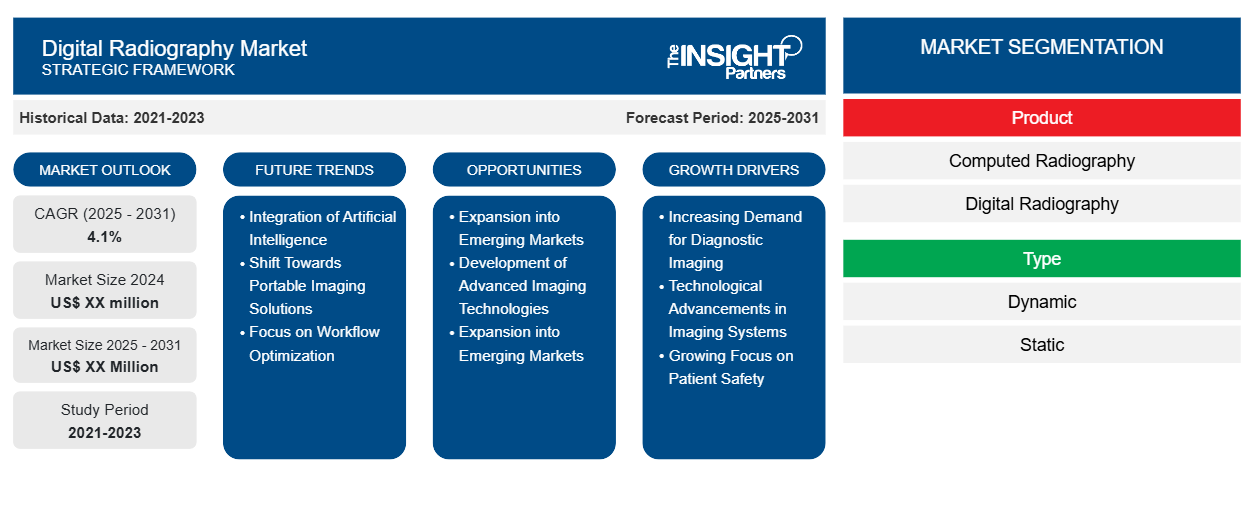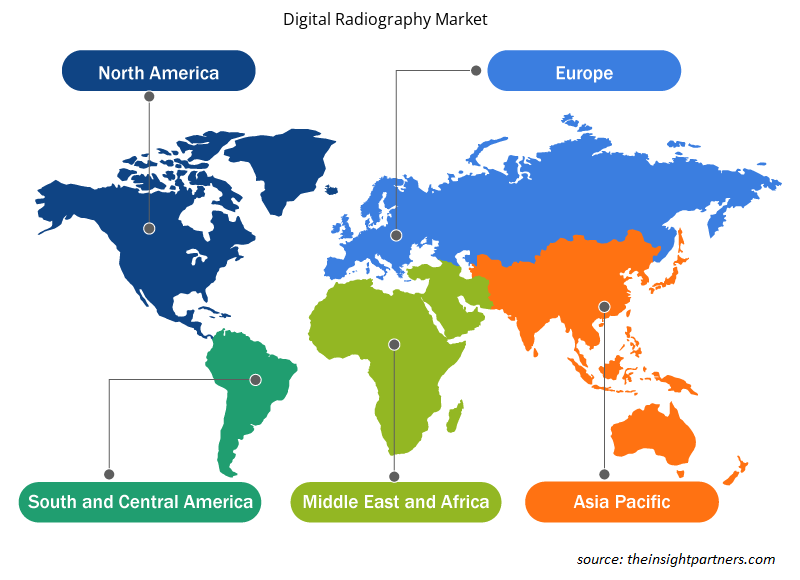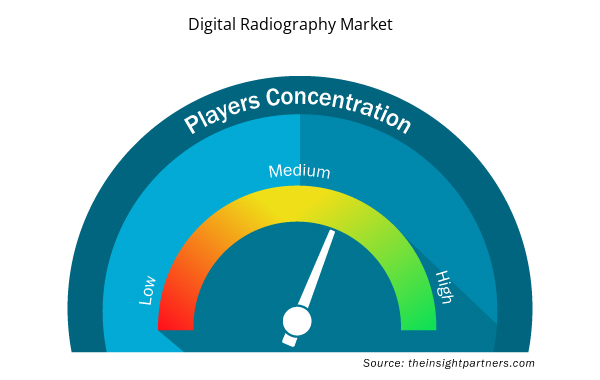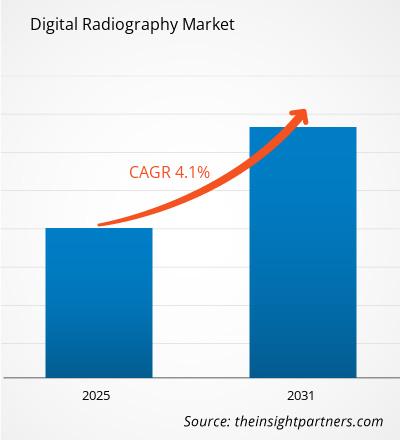Se espera que el mercado de radiografía digital registre una CAGR del 4,1 % entre 2025 y 2031, con un tamaño de mercado que se expandirá de US$ XX millones en 2024 a US$ XX millones en 2031.
El informe está segmentado por producto (radiografía computarizada, radiografía digital); tipo (dinámico, estático); aplicación (radiografía general, odontología, oncología, ortopedia, otros); usuario final (hospitales, clínicas, centros de diagnóstico, otros). El análisis global se desglosa a nivel regional y por países principales. El informe ofrece el valor en USD para el análisis y los segmentos mencionados.
Propósito del Informe
El informe "Mercado de Radiografía Digital" de The Insight Partners busca describir el panorama actual y el crecimiento futuro, los principales factores impulsores, los desafíos y las oportunidades. Esto proporcionará información a diversos actores del sector, como:
- Proveedores/Fabricantes de Tecnología: Para comprender la dinámica cambiante del mercado y conocer las oportunidades potenciales de crecimiento, lo que les permitirá tomar decisiones estratégicas informadas.
- Inversores: Realizar un análisis exhaustivo de tendencias respecto a la tasa de crecimiento del mercado, las proyecciones financieras del mercado y las oportunidades que existen en toda la cadena de valor.
- Organismos reguladores: Regular las políticas y las actividades policiales en el mercado con el objetivo de minimizar el abuso, preservar la confianza de los inversores y defender la integridad y estabilidad del mercado.
Segmentación del mercado de radiografía digital
Producto
- Radiografía computarizada
- Radiografía digital
Tipo
- Dinámica
- Estático
Solicitud
- Radiografía general
- Odontología
- Oncología
- Ortopédico
- Otros
Usuario final
- Hospitales
- Clínicas
- Centros de diagnóstico
- Otros
Personalice este informe según sus necesidades
Obtendrá personalización en cualquier informe, sin cargo, incluidas partes de este informe o análisis a nivel de país, paquete de datos de Excel, así como también grandes ofertas y descuentos para empresas emergentes y universidades.
Mercado de radiografía digital: perspectivas estratégicas

- Obtenga las principales tendencias clave del mercado de este informe.Esta muestra GRATUITA incluirá análisis de datos, desde tendencias del mercado hasta estimaciones y pronósticos.
Factores que impulsan el crecimiento del mercado de la radiografía digital
- Creciente demanda de diagnóstico por imagen: La creciente demanda de radiografía digital en el sector sanitario se ve impulsada por la creciente demanda de soluciones de diagnóstico por imagen. Un número cada vez mayor de pacientes padece enfermedades crónicas y lesiones, y se espera que los profesionales médicos realicen diagnósticos precisos y diseñen planes de tratamiento con tecnologías de imagen avanzadas. La radiografía digital ofrece resultados más rápidos, imágenes de alta calidad y dosis de radiación más bajas, por lo que es la modalidad preferida en los centros médicos modernos.
- Avances tecnológicos en sistemas de imagen: El mercado de la radiografía digital está muy influenciado por el rápido desarrollo técnico de los sistemas de imagen. Mejores detectores, software de procesamiento de imágenes mejorado y la integración de funciones de telemedicina hacen que la radiografía digital sea mucho más eficiente y fácil de usar. Estas tecnologías no solo mejoran la precisión diagnóstica, sino que también agilizan el trabajo en entornos sanitarios, lo que ha impulsado una mayor adopción de soluciones de radiografía digital.
- Enfoque creciente en la seguridad del paciente: Desde que la creciente importancia de la seguridad del paciente, junto con la reducción de la exposición a la radiación, se convirtió en un fuerte impulsor del mercado de la radiografía digital, los sistemas digitales introducen dosis bajas de radiación en comparación con los métodos basados en película. De esta forma, se mitiga la amenaza habitual que la radiación representa para los pacientes y el personal. Con la creciente comprensión de la importancia de la seguridad de los pacientes, se observa una mayor demanda en el mercado de la radiografía digital.
Tendencias futuras del mercado de la radiografía digital
- Integración de Inteligencia Artificial: La inteligencia artificial es otra tendencia crucial en el mercado de la radiografía digital. Una de las tendencias más prometedoras del sector es la tecnología de imágenes integrada con inteligencia artificial. Esta tecnología puede mejorar el análisis de imágenes basado en IA para realizar diagnósticos más rápidos y precisos. Esta tendencia no solo mejora la eficiencia del flujo de trabajo, sino que también ayuda al radiólogo a presentar mejores resultados y simplificar los procesos de diagnóstico.
- Transición hacia soluciones de imagenología portátiles: Esta transición hacia soluciones de imagenología portátiles está transformando el panorama actual del mercado de la radiografía digital. Fundamentales en su evolución hacia una mayor comodidad y accesibilidad, los sistemas de radiografía digital portátiles están comenzando a implementarse en la atención de urgencias, así como en ubicaciones remotas. Así, mediante la imagenología in situ, se puede lograr una mejor atención al paciente, reduciendo los tiempos de espera y facilitando el acceso a servicios de diagnóstico en muchos lugares.
- Enfoque en la optimización del flujo de trabajo: La optimización del flujo de trabajo ha cobrado impulso en el mercado de la radiografía digital debido a la necesidad de eficiencia en los entornos sanitarios. Los fabricantes han mejorado la eficacia mediante sistemas que facilitan los procedimientos de imagenología, se integran perfectamente con el historial clínico electrónico del paciente y promueven una mejor comunicación entre los equipos sanitarios. Esta tendencia no solo aumenta la eficiencia operativa, sino que también contribuye a una mejor experiencia diagnóstica para los pacientes.
Oportunidades del mercado de la radiografía digital
- Expansión a mercados emergentes: Abre importantes oportunidades de crecimiento para la radiografía digital en aquellos mercados emergentes donde la infraestructura sanitaria se ha convertido progresivamente en un problema. De hecho, a medida que se realizan esfuerzos regionales para modernizar su tecnología médica, las capacidades de diagnóstico incrementarán la demanda de soluciones de radiografía digital. Las empresas que se aventuran en estos mercados podrían asociarse con los proveedores de atención médica de estos lugares y aprovechar las oportunidades de crecimiento en el sector.
- Desarrollo de Tecnologías Avanzadas de Imagen: Las soluciones avanzadas de imagen adoptarán nuevas tecnologías digitales, incluyendo aquellas que podrían concebirse en las nuevas generaciones de radiografía digital, abriendo nuevas vías para el desarrollo de nuevas tecnologías de imagen. La imagen avanzada proporcionará los medios para la imagen 3D, la radiografía de energía dual y otras tecnologías de detección innovadoras que ofrecen un mejor rendimiento y resultados diagnósticos. La inversión en I+D en estas soluciones de vanguardia obligará a las empresas a desarrollar aún más sus ofertas actuales y a superar sus límites para satisfacer las necesidades que los profesionales sanitarios demandan constantemente.
- Expansión a mercados emergentes: La integración de soluciones de telesalud con la radiografía digital abre un nuevo mercado. El avance de las mejoras en telemedicina puede ir de la mano con la expansión de la atención al paciente mediante la integración de la imagenología y las consultas remotas. Las empresas aprovecharían este creciente potencial en telesalud para desarrollar sistemas que faciliten el intercambio de imágenes radiográficas entre diferentes profesionales de la salud y pacientes.
Perspectivas regionales del mercado de radiografía digital
Los analistas de Insight Partners han explicado detalladamente las tendencias y los factores regionales que influyen en el mercado de la radiografía digital durante el período de pronóstico. Esta sección también analiza los segmentos y la geografía del mercado de la radiografía digital en Norteamérica, Europa, Asia Pacífico, Oriente Medio y África, y Sudamérica y Centroamérica.

- Obtenga los datos regionales específicos para el mercado de radiografía digital
Alcance del informe de mercado de radiografía digital
| Atributo del informe | Detalles |
|---|---|
| Tamaño del mercado en 2024 | US$ XX millones |
| Tamaño del mercado en 2031 | US$ XX millones |
| CAGR global (2025-2031) | 4,1% |
| Datos históricos | 2021-2023 |
| Período de pronóstico | 2025-2031 |
| Segmentos cubiertos | Por producto
|
| Regiones y países cubiertos | América del norte
|
| Líderes del mercado y perfiles de empresas clave |
|
Densidad de actores del mercado de radiografía digital: comprensión de su impacto en la dinámica empresarial
El mercado de la radiografía digital está en rápido crecimiento, impulsado por la creciente demanda de los usuarios finales debido a factores como la evolución de las preferencias de los consumidores, los avances tecnológicos y una mayor conciencia de los beneficios del producto. A medida que aumenta la demanda, las empresas amplían su oferta, innovan para satisfacer las necesidades de los consumidores y aprovechan las tendencias emergentes, lo que impulsa aún más el crecimiento del mercado.
La densidad de actores del mercado se refiere a la distribución de empresas o compañías que operan en un mercado o sector en particular. Indica cuántos competidores (actores del mercado) hay en un mercado determinado en relación con su tamaño o valor total.
Las principales empresas que operan en el mercado de radiografía digital son:
- Rayos 3DX
- Bosello Alta Tecnología srl
- Canon, Inc
- Carestream Health
- Fresenius Se & Co. KGaA
Descargo de responsabilidad : Las empresas enumeradas anteriormente no están clasificadas en ningún orden particular.

- Obtenga una descripción general de los principales actores clave del mercado de radiografía digital
Puntos clave de venta
- Cobertura integral: el informe cubre de manera integral el análisis de productos, servicios, tipos y usuarios finales del mercado de radiografía digital, proporcionando un panorama holístico.
- Análisis de expertos: el informe se compila con base en el conocimiento profundo de expertos y analistas de la industria.
- Información actualizada: El informe asegura relevancia comercial debido a su cobertura de información reciente y tendencias de datos.
- Opciones de personalización: este informe se puede personalizar para satisfacer los requisitos específicos del cliente y adaptarse adecuadamente a las estrategias comerciales.
Por lo tanto, el informe de investigación sobre el mercado de la radiografía digital puede ayudar a descifrar y comprender el panorama de la industria y sus perspectivas de crecimiento. Si bien existen algunas preocupaciones válidas, las ventajas generales de este informe suelen superar las desventajas.
- Análisis histórico (2 años), año base, pronóstico (7 años) con CAGR
- Análisis PEST y FODA
- Tamaño del mercado Valor/volumen: global, regional, nacional
- Industria y panorama competitivo
- Conjunto de datos de Excel


- 3D Mapping and Modelling Market
- Biopharmaceutical Tubing Market
- Small Internal Combustion Engine Market
- Latent TB Detection Market
- Explosion-Proof Equipment Market
- Artificial Intelligence in Healthcare Diagnosis Market
- Digital Language Learning Market
- Europe Industrial Chillers Market
- Data Center Cooling Market
- Pipe Relining Market

Report Coverage
Revenue forecast, Company Analysis, Industry landscape, Growth factors, and Trends

Segment Covered
This text is related
to segments covered.

Regional Scope
North America, Europe, Asia Pacific, Middle East & Africa, South & Central America

Country Scope
This text is related
to country scope.
Preguntas frecuentes
increasing demand for diagnostic imaging and technological advancement in imaging systems are the major factors boosting the digital radiography market growth
3DX-Ray, Bosello High Technology srl, Canon, Inc, Carestream Health, Fresenius Se & Co. KGaA, FUJIFILM Holdings Corporation, Koninklijke Philips N.V., North Star Imaging Inc, Shimadzu Corporation, Toshiba Medical System Corporation are the some of the key market players operating in the digital radiography market
The market is expected to grow at a CAGR of 4.1%
The final report will duly include market size and projection estimates for all the segments from 2021 to 2031, along with a revenue share and compound annual growth rate (%) for the regional/country-wise market wherein 2021-2022 are the historic years, 2023 is considered to be the base year, and the forecast will be provided till 2031, along with CAGR (%)
The North America region accounts for highest revenue share digital radiography market
Asia Pacific is estimated to grow at the highest CAGR over the forecast year (2023 - 2031)
Trends and growth analysis reports related to Life Sciences : READ MORE..
1. 3DX-Ray
2. Bosello High Technology srl
3. Canon, Inc
4. Carestream Health
5. Fresenius Se & Co. KGaA
6. FUJIFILM Holdings Corporation
7. Koninklijke Philips N.V.
8. North Star Imaging Inc.
9. Shimadzu Corporation
10. Toshiba Medical System Corporation
The Insight Partners performs research in 4 major stages: Data Collection & Secondary Research, Primary Research, Data Analysis and Data Triangulation & Final Review.
- Data Collection and Secondary Research:
As a market research and consulting firm operating from a decade, we have published and advised several client across the globe. First step for any study will start with an assessment of currently available data and insights from existing reports. Further, historical and current market information is collected from Investor Presentations, Annual Reports, SEC Filings, etc., and other information related to company’s performance and market positioning are gathered from Paid Databases (Factiva, Hoovers, and Reuters) and various other publications available in public domain.
Several associations trade associates, technical forums, institutes, societies and organization are accessed to gain technical as well as market related insights through their publications such as research papers, blogs and press releases related to the studies are referred to get cues about the market. Further, white papers, journals, magazines, and other news articles published in last 3 years are scrutinized and analyzed to understand the current market trends.
- Primary Research:
The primarily interview analysis comprise of data obtained from industry participants interview and answers to survey questions gathered by in-house primary team.
For primary research, interviews are conducted with industry experts/CEOs/Marketing Managers/VPs/Subject Matter Experts from both demand and supply side to get a 360-degree view of the market. The primary team conducts several interviews based on the complexity of the markets to understand the various market trends and dynamics which makes research more credible and precise.
A typical research interview fulfils the following functions:
- Provides first-hand information on the market size, market trends, growth trends, competitive landscape, and outlook
- Validates and strengthens in-house secondary research findings
- Develops the analysis team’s expertise and market understanding
Primary research involves email interactions and telephone interviews for each market, category, segment, and sub-segment across geographies. The participants who typically take part in such a process include, but are not limited to:
- Industry participants: VPs, business development managers, market intelligence managers and national sales managers
- Outside experts: Valuation experts, research analysts and key opinion leaders specializing in the electronics and semiconductor industry.
Below is the breakup of our primary respondents by company, designation, and region:

Once we receive the confirmation from primary research sources or primary respondents, we finalize the base year market estimation and forecast the data as per the macroeconomic and microeconomic factors assessed during data collection.
- Data Analysis:
Once data is validated through both secondary as well as primary respondents, we finalize the market estimations by hypothesis formulation and factor analysis at regional and country level.
- Macro-Economic Factor Analysis:
We analyse macroeconomic indicators such the gross domestic product (GDP), increase in the demand for goods and services across industries, technological advancement, regional economic growth, governmental policies, the influence of COVID-19, PEST analysis, and other aspects. This analysis aids in setting benchmarks for various nations/regions and approximating market splits. Additionally, the general trend of the aforementioned components aid in determining the market's development possibilities.
- Country Level Data:
Various factors that are especially aligned to the country are taken into account to determine the market size for a certain area and country, including the presence of vendors, such as headquarters and offices, the country's GDP, demand patterns, and industry growth. To comprehend the market dynamics for the nation, a number of growth variables, inhibitors, application areas, and current market trends are researched. The aforementioned elements aid in determining the country's overall market's growth potential.
- Company Profile:
The “Table of Contents” is formulated by listing and analyzing more than 25 - 30 companies operating in the market ecosystem across geographies. However, we profile only 10 companies as a standard practice in our syndicate reports. These 10 companies comprise leading, emerging, and regional players. Nonetheless, our analysis is not restricted to the 10 listed companies, we also analyze other companies present in the market to develop a holistic view and understand the prevailing trends. The “Company Profiles” section in the report covers key facts, business description, products & services, financial information, SWOT analysis, and key developments. The financial information presented is extracted from the annual reports and official documents of the publicly listed companies. Upon collecting the information for the sections of respective companies, we verify them via various primary sources and then compile the data in respective company profiles. The company level information helps us in deriving the base number as well as in forecasting the market size.
- Developing Base Number:
Aggregation of sales statistics (2020-2022) and macro-economic factor, and other secondary and primary research insights are utilized to arrive at base number and related market shares for 2022. The data gaps are identified in this step and relevant market data is analyzed, collected from paid primary interviews or databases. On finalizing the base year market size, forecasts are developed on the basis of macro-economic, industry and market growth factors and company level analysis.
- Data Triangulation and Final Review:
The market findings and base year market size calculations are validated from supply as well as demand side. Demand side validations are based on macro-economic factor analysis and benchmarks for respective regions and countries. In case of supply side validations, revenues of major companies are estimated (in case not available) based on industry benchmark, approximate number of employees, product portfolio, and primary interviews revenues are gathered. Further revenue from target product/service segment is assessed to avoid overshooting of market statistics. In case of heavy deviations between supply and demand side values, all thes steps are repeated to achieve synchronization.
We follow an iterative model, wherein we share our research findings with Subject Matter Experts (SME’s) and Key Opinion Leaders (KOLs) until consensus view of the market is not formulated – this model negates any drastic deviation in the opinions of experts. Only validated and universally acceptable research findings are quoted in our reports.
We have important check points that we use to validate our research findings – which we call – data triangulation, where we validate the information, we generate from secondary sources with primary interviews and then we re-validate with our internal data bases and Subject matter experts. This comprehensive model enables us to deliver high quality, reliable data in shortest possible time.

 Obtenga una muestra gratuita de este informe
Obtenga una muestra gratuita de este informe